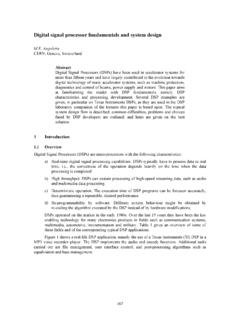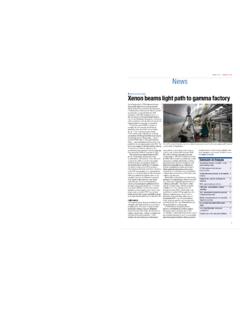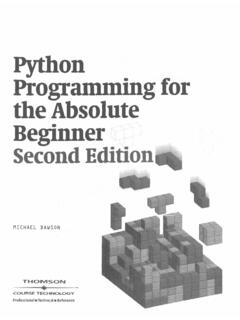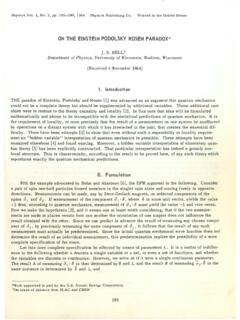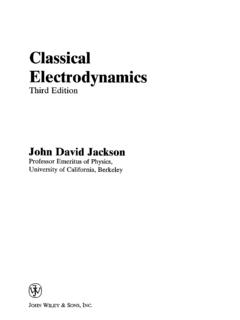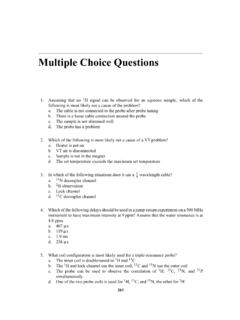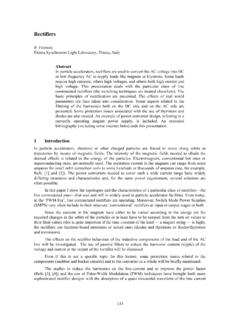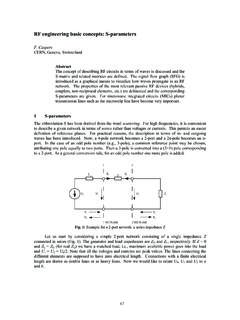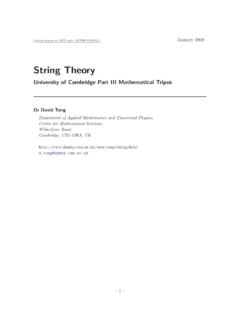Transcription of INTRODUCTION TO SUPERSTRING THEORY - CERN
1 CERN-TH/97-218hep-th/9709062 INTRODUCTION TO SUPERSTRING THEORYE lias Kiritsis THEORY Division, CERN,CH-1211, Geneva 23, SWITZERLANDA bstractIn these lecture notes, an INTRODUCTION to SUPERSTRING THEORY is presented. Classi-cal strings, covariant and light-cone quantization, supersymmetric strings, anomalycancelation, compacti cation, T-duality, supersymmetry breaking, and thresholdcorrections to low-energy couplings are discussed. A brief INTRODUCTION to non-perturbative duality symmetries is also presented at the Catholic University of Leuven andat the University of Padova during the academic year be published by Leuven University 1997 e-mail: Introduction22 Historical perspective33 Classical string Relativisticstrings .. Oscillator 164 Quantization of the bosonic Covariantcanonicalquantization .. Pathintegralquantization.
2 BRST primer .. BRST instringtheoryandthephysicalspectrum .. 305 Interactions and loop amplitudes336 Conformal eld Conformallyinvariant Example:thefreeboson .. Thecentralcharge .. Thefreefermion .. Modeexpansions .. nealgebras .. Free fermions and O(N) a ne N=1 superconformal N=2 superconformal N=4 superconformal .. 687 CFT on the Enhanced symmetry and the string Higgs e T-duality .. Freefermionsonthetorus .. 948 Scattering amplitudes and vertex operators of bosonic strings959 Strings in background elds and low-energy e ective actions9910 Superstrings and (type-II) .. Supersymmetric e ective 11611 Anomalies11912 Compacti cation and supersymmetry cations .. cationonnon-trivialmanifolds.
3 World-sheet versus spacetime Heterotic orbifold compacti cations with N=2 Spontaneous supersymmetry breaking .. 15413 Loop corrections to e ective couplings in string .. (1)' ,2examplesofthresholdcorrections .. 17514 Non-perturbative string dualities: a Antisymmetric tensors and p-branes .. BPS states and M- THEORY and the E8 .. D-branes are the type-IIR-Rchargedstates .. 20115 Outlook208 Acknowledgments209 AppendixA:Thetafunctions .. 210 AppendixB:Toroidallatticesums .. 213 AppendixC:ToroidalKaluza-Kleinreduction .. 216 AppendixD:N=1,2,4,D=4supergravitycoupled tomatter .. 218 Appendix E: BPS multiplets and helicity supertrace formulae .. 221 AppendixF:Modularforms .. 229 AppendixG:Helicitystringpartitionfunctio ns .. 2313 AppendixH:Electric-MagneticdualityinD=4 .. 237 References24041 IntroductionString THEORY has been the leading candidate over the past years for a THEORY that consis-tently uni es all fundamental forces of nature, including gravity.
4 In a sense, the theorypredicts gravity and gauge symmetry around flat space. Moreover, the THEORY is UV- nite. The elementary objects are one-dimensional strings whose vibration modes shouldcorrespond to the usual elementary distances large with respect to the size of the strings, the low-energy excitations canbe described by an e ective eld THEORY . Thus, contact can be established with quantum eld THEORY , which turned out to be successful in describing the dynamics of the real worldat low will try to explain here the basic structure of string THEORY , its predictions and chapter 2 the evolution of string THEORY is traced, from a THEORY initially built todescribe hadrons to a \ THEORY of everything". In chapter 3 a description of classical bosonicstring THEORY is given. The oscillation modes of the string are described, preparing the scenefor quantization.
5 In chapter 4, the quantization of the bosonic string is described. All threedi erent quantization procedures are presented to varying depth, since in each one somespeci c properties are more transparent than in others. I thus describe the old covariantquantization, the light-cone quantization and the modern path-integral quantization. Inchapter 6 a concise INTRODUCTION is given, to the central concepts of conformal eld theorysince it is the basic tool in discussing rst quantized string THEORY . In chapter 8 thecalculation of scattering amplitudes is described. In chapter 9 the low-energy e ectiveaction for the massless modes is chapter 10 superstrings are introduced. They provide spacetime fermions and real-ize supersymmetry in spacetime and on the world-sheet. I go through quantization again,and describe the di erent supersymmetric string theories in ten dimensions.
6 In chapter 11gauge and gravitational anomalies are discussed. In particular it is shown that the super-string theories are anomaly-free. In chapter 12 compacti cations of the ten-dimensionalsuperstring theories are described. Supersymmetry breaking is also discussed in this con-text. In chapter 13, I describe how to calculate loop corrections to e ective couplingconstants. This is very important for comparing string THEORY predictions at low energywith the real world. In chapter 14 a brief INTRODUCTION to non-perturbative string con-nections and non-perturbative e ects is given. This is a fast-changing subject and I havejust included some basics as well as tools, so that the reader orients him(her)self in theweb of duality connections. Finally, in chapter 15 a brief outlook and future problems have added a number of appendices to make several technical discussions Appendix A useful information on the elliptic#-functions is included.
7 In Appendix B,I rederive the various lattice sums that appear in toroidal compacti cations. In AppendixC the Kaluza-Klein ansatz is described, used to obtain actions in lower dimensions aftertoroidal compacti cation. In Appendix D some facts are presented about four-dimensionallocally supersymmetric theories with N=1,2,4 supersymmetry. In Appendix E, BPS statesare described along with their representation THEORY and helicity supertrace formulae thatcan be used to trace their appearance in a supersymmetric THEORY . In Appendix F factsabout elliptic modular forms are presented, which are useful in many contexts, notablyin the one-loop computation of thresholds and counting of BPS multiplicities. In Ap-pendix G, I present the computation of helicity-generating string partition functions andthe associated calculation of BPS multiplicities. Finally, in Appendix H, I briefly reviewelectric{magnetic duality in four have not tried to be complete in my referencing.}
8 The focus was to provide, in mostcases, appropriate reviews for further reading. Only in the last chapter, which coversvery recent topics, I do mostly refer to original papers because of the scarcity of Historical perspectiveIn the sixties, physicists tried to make sense of a big bulk of experimental data relevantto the strong interaction. There were lots of particles (or \resonances") and the situationcould best be described as chaotic. There were some regularities observed, though: Almost linear Regge behavior. It was noticed that the large number of resonancescould be nicely put on (almost) straight lines by plotting their mass versus their spinm2=J 0;( )with 0 1 GeV 2, and this relation was checked up toJ=11=2. s-t duality. If we consider a scattering amplitude of two!two hadrons (1;2!3;4),then it can be described by the Mandelstam invariantss= (p1+p2)2;t= (p2+p3)2;u= (p1+p3)2;( )withs+t+u=Pim2i.
9 We are using a metric with signature ( + ++). Such an ampli-tude depends on the flavor quantum numbers of hadrons (for example SU(3)). Considerthe flavor part, which is cyclically symmetric in flavor space. For the full amplitude tobe symmetric, it must also be cyclically symmetric in the momentapi. This symmetryamounts to the interchanget$s. Thus, the amplitude should satisfyA(s;t)=A(t;s).Consider at-channel contribution due to the exchange of a spin-Jparticle of , at high energyAJ(s;t) ( s)Jt M2:( )Thus, this partial amplitude increases withsand its behavior becomes worse for largevalues ofJ. If one sews amplitudes of this form together to make a loop amplitude, thenthere are uncontrollable UV divergences forJ>1. Any nite sum of amplitudes of theform ( ) has this bad UV behavior. However, if one allows an in nite number of termsthen it is conceivable that the UV behavior might be di erent.
10 Moreover such a nite sumhas nos-channel proposal for such a dual amplitude was made by Veneziano [1]A(s;t)= ( (s)) ( (t)) ( (s) (t));( )where is the standard -function and (s)= (0) + 0s:( )By using the standard properties of the -function it can be checked that the amplitude( ) has an in nite number ofs;t-channel poles:A(s;t)= 1Xn=0( (s)+1):::( (s)+n)n!1 (t) n:( )In this expansion thes$tinterchange symmetry of ( ) is not manifest. The polesin ( ) correspond to the exchange of an in nite number of particles of massM2=(n (0)= 0) and high spins. It can also be checked that the high-energy behavior ofthe Veneziano amplitude is softer than any local quantum eld THEORY amplitude, and thein nite number of poles is crucial for was subsequently realized by Nambu and Goto that such amplitudes came out of the-ories of relativistic strings.
